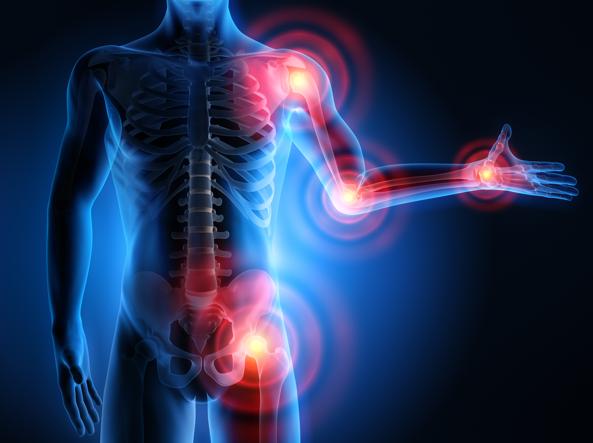Joints and tendons: how to keep them healthy?
1) What are joints?
Anatomically, the term 'joint' defines a complex of structures that keep two or more bony surfaces in contact. The joint thus represents a set of elements (fibrous and/or cartilaginous tissue, ligaments, capsules, membranes) that regulate the connection between two bony heads. There are three different types of joints:
- mobile (wrist, hand, fingers, knee, shoulder, elbow, etc.);
- semi-mobile (spinal column, etc.);
- fixed (skull, pelvis, etc.). [1]
Within the joints, the bone heads are lined by articular cartilage. These are highly hydrated structures, as they are composed of collagen fibres, arranged to form microcells containing water-binding molecules.

2) What are tendons?
Tendons are strong, pearly-coloured fibrous structures that bind muscles to bones or other insertion structures.
Collagen fibres make up 65 to 80 % of the structure of tendons and ligaments
3) The importance of healthy joints and tendons
Joints are important mechanisms in our bodies. Depending on the type, they provide us with stability and mobility, enabling everyday activities.
The main function of tendons is to transmit the force exerted by muscles to the structures to which they are connected. In order to withstand all these often violent stresses, tendons are endowed with high strength and minimal elasticity.
4) Perché le articolazioni invecchiano con l’usura e l’età?
Excessive and continuous strain on the joints leads to a real breakdown of the collagen fibres, resulting in the release of water-binding molecules. Obviously, depending on the type of work performed, the sport practised and the posture, specific joints may deteriorate prematurely. If left untreated, inflammation of individual joint parts can lead to multiple joint diseases, including tendonitis.
As we age, our bodies undergo a physiological process of dehydration, which leads to a decrease in microcellular tissue and, therefore, a reduced thickness of joint cartilage.
In addition, certain systemic connective tissue diseases can lead to inflammation of the joints with possible arthritis problems in the future.
5) The effect of sport on joints and tendons
Sport, despite the many benefits it brings to the body, can cause chronic pain caused by collagen degradation in joints and tendons. Intense muscular exertion with heavy loads and daily training concentrated on the same part of the body can promote the occurrence of these pains.[2]
Le conseguenze di questi dolori cronici sono lesioni croniche come la tendinopatia rotulea e achillea. Inoltre, più si avanza con l'età, più questi dolori possono indurre disturbi degenerativi delle articolazioni come la condropatia o, peggio, l'osteoartrite.
6) What can you do to keep your joints young and healthy?
Here is a series of tips to prevent joint problems and the resulting functional limitations:
- weight loss in the case of overweight individuals
- physical activity and stretching
- varied and balanced diet
- collagen-based food supplements to strengthen and support the collagen fibres in joint cartilage.[3]
The food supplement wavecollagen in addition to containing hydrolysed marine collagen, is fortified with other molecules with antioxidant and protective activity such as hyaluronic acid and vitamin C. This specific formulation enables wavecollagen to contribute to normal collagen formation for normal cartilage function.

7) The benefits of collagen for joints and tendons
Collagen is the primary component of cartilage. For this reason, collagen-based dietary supplements, fortified with hyaluronic acid and vitamin C, can be an essential aid to the health of our joints. Particularly in individuals who put particular strain on their joints due to work or sport, these supplements can increase the ability of joints to produce collagen and thus reduce joint and muscle inflammation.[3]
In addition, as collagen fibres make up 65 to 80 % of the structure of tendons and ligaments, a collagen supplement can be a good ally in the prevention and alleviation of tendonitis. [4]
[1] https://www.humanitas.it/enciclopedia/anatomia/apparato-muscolo-scheletrico/articolazioni/
[2] https://www.chuv.ch/fileadmin/sites/cms/documents/douleurs_dans_la_pratique_sportive.pdf
[3] Clark, K. L., Sebastianelli, W., Flechsenhar, K. R., Aukermann, D. F., Meza, F., Millard, R. L., Deitch, J. R., Sherbondy, P. S., & Albert, A. (2008). 24-Week study on the use of collagen hydrolysate as a dietary supplement in athletes with activity-related joint pain. Current medical research and opinion, 24(5), 1485–1496. https://doi.org/10.1185/030079908x291967.
[4] A double-blind, placebo-controlled, randomised, clinical study on the effectiveness of collagen peptide on osteoarthritis. Kumar S, Sugihara F, Suzuki K, Inoue N, Venkateswarathirukumara S. J Sci Food Agric. 2015 Mar 15;95(4):702-7.
[5] The effects of collagen hydrolysat on symptoms of chronic fibromyalgia and temporomandibular joint pain. Olson GB, Savage S, Olson J. Cranio. 2000 Apr;18(2):135-41.

